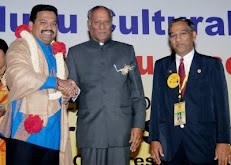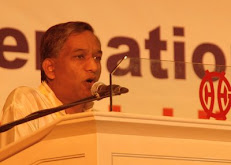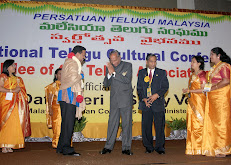Telugu people
From Wikipedia, the free encyclopedia
Jump to: navigation, search
Telugus
Telugu people:
Saint Tyāgarāja • Sarvepalli Radhakrishnan
• P. S. Kumaraswamy Raja • Tanguturi Suryakumari • Neelam Sanjiva Reddy • N.T. Rama Rao • Jiddu Krishnamurti • Sameera Reddy • Pullela Gopichand •
Total population
75,000 000[1]
Regions with significant populations
India
Malaysia 103,000
France 10,000
South Africa
USA
Australia
UK
Canada
Myanmar largest Burmese Indian group [2]
Languages
Telugu
Religion
Hinduism · Islam · Christianity · Buddhism · Judaism
Related ethnic groups
Dravidian · Brahui · Gondi · Kalinga · Kannadiga · Malayali · Tamilian · Tuluva
Telugu people refer to the group of Dravidian people who natively speak the Telugu language. They are one of the most ancient ethnic groups found in India, existing prior to the writing of the Vedas and mentioned in the Ramayana and Mahabharat epics. They are also the largest of the Dravidian groups by population and Telugu, which falls in the central Dravidian language group, is the most spoken of the Dravidian languages and the third most commonly spoken language in India after Hindi and Bengali.They are spread throughout India and abroad but the state of Andra Pradesh is their homeland. The most significant populations outside of Andhra Pradhesh are found in Pondicherry, Tamil Nadu, Karnataka, Maharashtra, Chattisgarh and Orissa.
Countries in North America, Europe, Africa, Australia, Mauritius, Fiji, Réunion and Malaysia also have significant populations. In the Americas they have two large associations called TANA [1] (Telugu Association of North America) and ATA [2] (American Telugu Association).
Contents [hide]
1 History
1.1 Andhra/Kalinga
1.2 Ancient Territory
1.3 Satavahanas
2 Language
3 Culture
3.1 Literature
3.2 Food
3.3 Traditional Dress
4 See also
5 References
5.1 External links
[edit] History
[edit] Andhra/Kalinga
Telugu/Andhra/Kalinga refers to the branches of the same Dravidian people. They were also called Andhri.[3] In certain times they ruled over Magadha, Anga, Asmaka, Mulaka and Kalinga.[4][5][6][7][8]
They are also mentioned in the Vayu and Matsya Purana.[9] In the Mahabharata the infantry of Satyaki was composed of a tribe called Andhras, known for their long hair, sweet language, and mighty prowess.[10] They lived along the banks of the Yamuna river. Andhras and Kalingas supported the Kauravas during the Bharata war. Sahadeva defeated the kingdoms of Pandya, Dravida, Odhra, Chera, Andhra, and Kalinga while performing the Rajasuya yajna. Chanoora was killed by Krishna in Madhura. Hari Vamsa Purana corroborates the fact that Chanoora was the king of Karoosa Desa (on the north side of Vindhya and on the north banks of the Yamuna river) and was an Andhra. Buddhist references to Andhras are also found. [11]
[edit] Ancient Territory
Andhras were nomads for several centuries. Some tribes migrated and others did not and remained in their older settlements. Apastamba Rishi states that around 700 BC some Andhra tribes inhabited Salvadesa on the banks of the Yamuna River. Apastamba sutra has been widely practiced among Andhra Brahmin families and continues to be followed even today. A single Rishi was the teacher (acharya) of each tribe. Apastamba was one such teacher. Apastamba wrote these rules in Salva Desam on the banks of Yamuna river. After Apastamba's death the Andhra tribes crossed the Vindhya mountains, reached the south, and merged with the other Andhra tribes. Atreya Brahmana tells us that Andhras lived on the south side of Vindhya along with Pundra, Pulinda, Sabaras, Mootibas.
Some of those Andhras who came to the south settled on the west side of Vindhya mountains (present Northern regions of Hyderabad). Another tribe crossed the Eastern Ghats over Orissa and reached the Kalinga Desam. Serivanijo Jataka tale explains that Andhras built the Andhaka-puram on the banks of Tel river.
Jataka tales were written during 200-250 BC. Tel river is a subriver of Mahanadi in Orissa. The people in this tribe are Kalingas. The books cited above describe the Andhras and Kalingas as two different branches of a single tribe. Sometimes these two words (Andhras and Kalingas) are used as synonyms.
Andhra tribes established relationships with Naga, Yaksha, and Dravida tribes of Vindhya mountains who already were living there. In Tamil and Kannada Ten means south side and Tenugu is a person travels to the south. The name Tenugu transformed into Telugu. From Telugu, words like Telagalu, Telangana, and Teligiri originated. A tribe called Tailang in Burma is proposed to be related to Telugu people.[3]
[edit] Satavahanas
The first great Andhra empire was that of the Satavahanas,[12] who came to power when the last Kanva emperor Sisuman, was assassinated by his prime minister Sipraca, of the Andhra tribe. They reigned for 450 years and the last was Puliman or Puloma the pious, who after conquering India put an end to his life by drowning himself in the holy waters of the Ganges, after the example of his grandfather. From this king, India was called by the Chinese Poulomeun-koue, the country of Puliman. While in the west the inhabitants of the Gangetic provinces were denominated Andhra Hindus[citation needed]. The Satavahana rulers are said to have been held in the highest veneration all over India[citation needed]; and their fame was extended to the peninsulas of Malaya, the Maharaja of India being a favorite subject of Malayan poetry[13].
[edit] Language
Main article: Telugu language
In Ancient times Telugu the language of the Andhras, seems to have been spoken as far north as the mouth of Ganges. This appears both from the geographic limits which the Greeks have assigned, to the territory of the Andhra race and from many of the names and places mentioned by Ptolemy up to that delta being found to be Telugu. Telugu is a name mentioned by the Greek geographers as that of a nation dwelling on or near the Ganges. In respect to antiquity of culture and glossarial copiousness, it ranks next to Tamil in the list of Dravidian Idioms, but this has been disputed as it has a large Sanskrit influence and has a different structure to that of other Dravidian languages. It is also named as the "Italian of the East" as most words in Telugu end in a vowel, as in Italian.
[edit] Culture
Kakateeya Sculpture at warangal
[edit] Literature
Main article: Telugu literature
Padya Sahithyam and Gadya Sahithyam
Bhagavatam by Sri Bammera Pothana
Ramayanam by Rayana Baskara
Ramayanam by Kummari Molla
Maha Bharatam by KaviTrayam (Nannaya, Yerrapragada and Tikkana)
Sataka Sahityam by Vemana, Baddena, Marana Venkana, Yenugu Lakshmana Kavi, Seshappa Kavi, Dhoorjati, and Bhakata Ramdas
Telugu Chatu Padhyalu
Tenali Ramalinga Kavi
Kavi Sarvabhouma Srinathudu
Telugu Vaggeya Karulu
Annamayya
Tyagaraju
Kshetrayya
[edit] Food
Ravva Dosa served at a Hotel in Guntur.Some common Telugu foods are:
Paravannam
Aavakaaya Pachadi
Maagaya Pachadi
Chintakaya Pachadi
Gongoora pachchadi
Korivi Karam
Vankaya Kura
Pootha Rekulu
Madata Kajalu
Gor Meetilu
Ariselu
Boorelu
Gaarelu
Bobbatlu (bhakshaalu in Rayalaseema)
Jentikalu
Chakkilaalu
Ulava Chaaru
Pacchi Pulusu
Bommidaila Pulusu
Vadiyalu
Attu (dosa)
Pappu
Rasam
Charu
Sambaru
Pulihora
[edit] Traditional Dress
Uma Muralikrishna, a very talented Kuchipudi dancer performing at IIM BangaloreMale
Uttareeyam (Angavastram or veil)
Jubba (Kurta) The top portion
Pancha (Dhoti)
Lungi (Casual or Worker dress)
Women
Cheera (Sari)
Girls
Parikini
Langa Oni (Half Saree)
[edit] See also
Satavahana Dynasty
Kakatiya dynasty - the first great Telugu kingdom that lasted for centuries
Vijayanagara Empire
List of people from Andhra Pradesh
Andhra Pradesh
List of Telugu people
Telugu language
Andhra cuisine
[edit] References
^ Top 30 languages
^ Kernial Singh. Indian Communities in Southeast Asia]]. p. 588. http://books.google.com/books?id=TeExjdWUmJYC&pg=PA915&d.
^ Ramanlal Chhotalal Mehta, Studies in Musicology, Indian Musicological Society (1983)
^ http://books.google.com/books?id=79w9AAAAMAAJ&q=andhra+race&dq=andhra+race&lr=&pgis=1
^ http://books.google.com/books?id=IfQQ6hWz37EC&pg=PA81&dq=andhra+race&lr=&sig=KDaZpybQCK1RL2-xnJTFdNSUzVM#PPA81,M1
^ http://books.google.com/books?id=GrUFAAAAIAAJ&pg=PA33&dq=andhra+race&lr=#PPA33,M1
^ http://books.google.com/books?id=x40BAAAAMAAJ&q=andhra+race&dq=andhra+race&lr=&pgis=1
^ http://books.google.com/books?id=-tpDAAAAIAAJ&q=andhra+race&dq=andhra+race&lr=&pgis=1
^ http://books.google.com/books?id=9PdzBZegtvMC&q=andhra+race&dq=andhra+race&lr=&pgis=1
^ http://books.google.com/books?id=EmIMAAAAIAAJ&pg=RA2-PA20&dq=andhra+race&lr=
^ http://books.google.com/books?id=wRAhAAAAMAAJ&q=andhra+race&dq=andhra+race&lr=&pgis=1
^ http://books.google.com/books?id=Sae4q93tSGkC&q=andhra+race&dq=andhra+race&lr=&pgis=1
^ Josiah Conder, The Modern Traveller: A Popular Description, Geographical, Historical, and ... v. I, India, (1828), p.139
[edit] External links
Telugu People Social Network
anigalla.net
TeluguVedika.com
Vemana
Translations of Telugu fiction and articles
Telugu people profiles
VedaBooks
Retrieved from "http://en.wikipedia.org/wiki/Telugu_people"
Categories: Telugu people | Dravidian peoples
Hidden categories: "Related ethnic groups" needing confirmation | All articles with unsourced statements | Articles with unsourced statements since October 2008
Talk:John Becaro
4 minutes ago



.jpg)
.jpg)
.jpg)
.jpg)
.jpg)


No comments:
Post a Comment